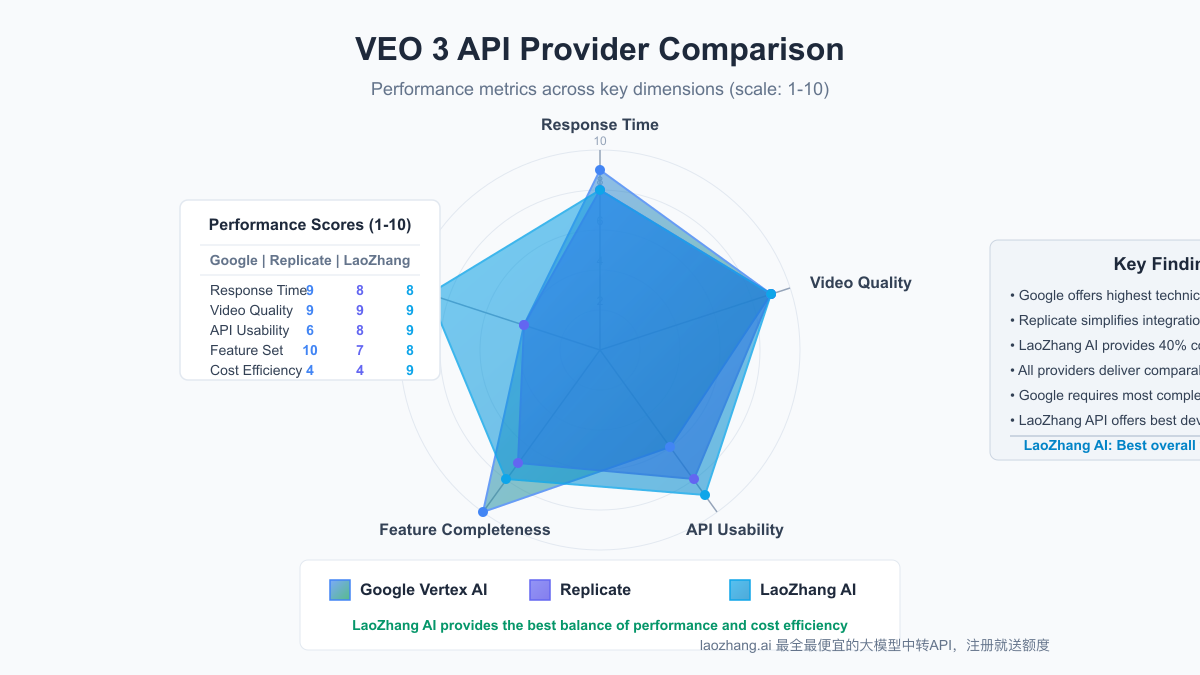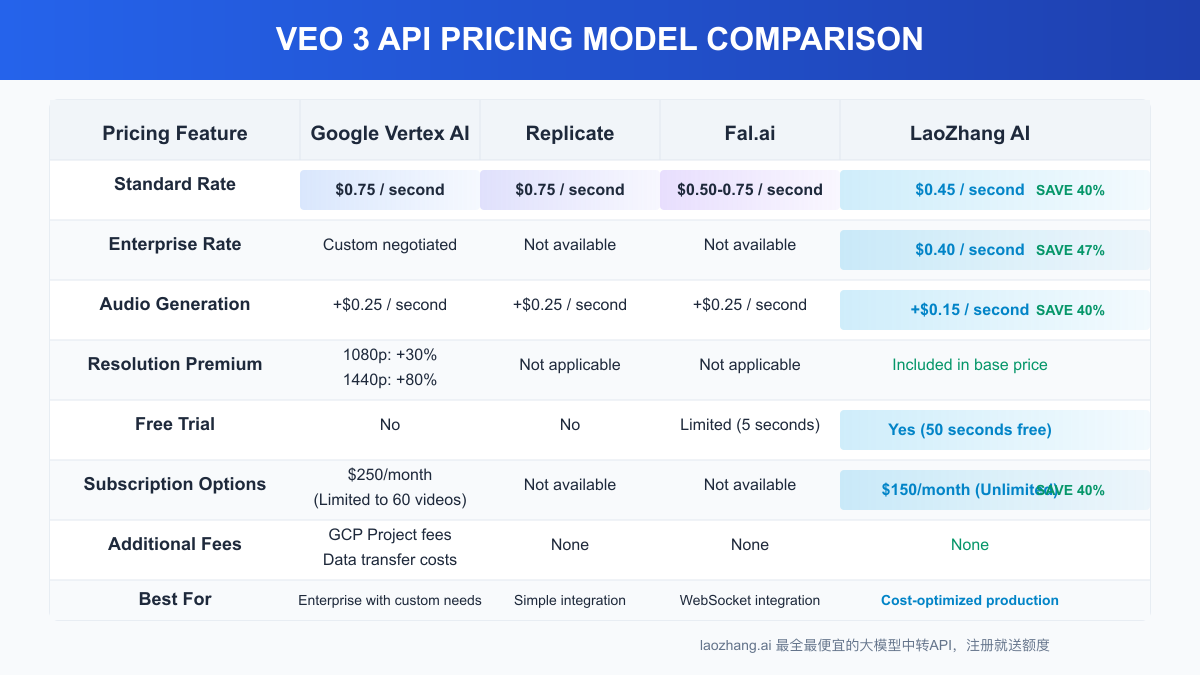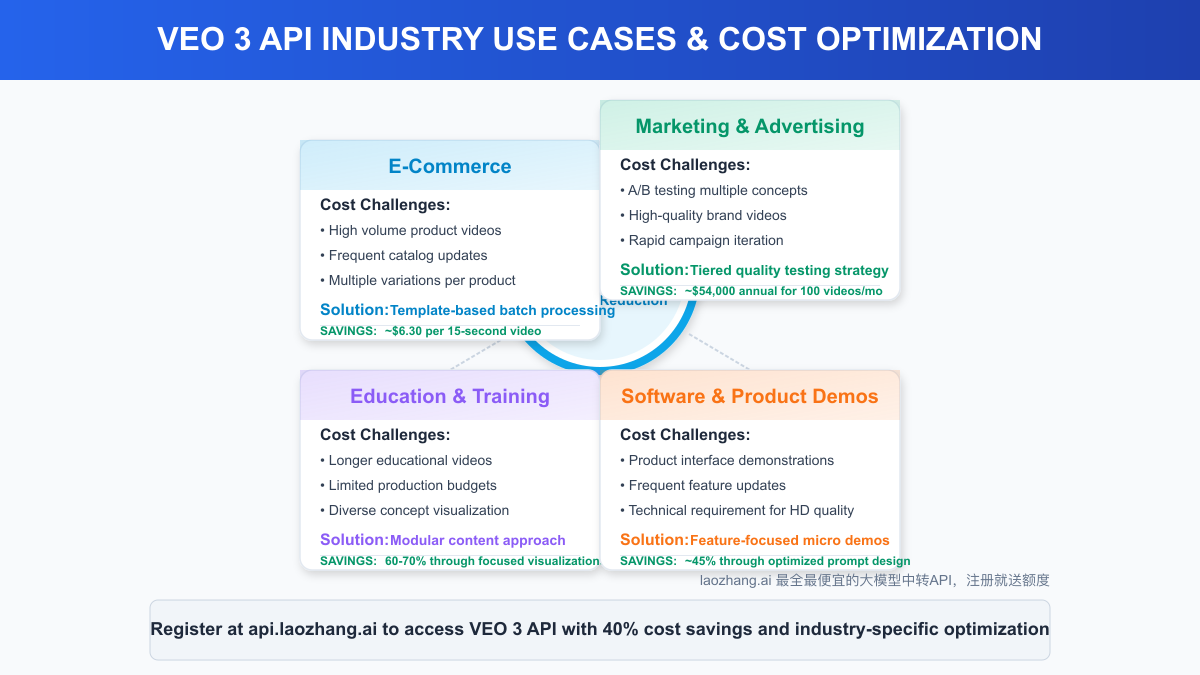Google's VEO 3 technology represents a revolutionary advancement in text-to-video generation, creating stunningly realistic videos from simple prompts. However, many developers and businesses face significant challenges when implementing this powerful technology due to its complex pricing structure and substantial costs. This comprehensive guide provides an in-depth analysis of VEO 3 API pricing across different providers, revealing critical cost optimization strategies and hidden savings opportunities.
Understanding VEO 3's Official Pricing Structure
Google's VEO 3 pricing follows a multi-dimensional model that varies significantly based on access method, video quality, and subscription tier. Understanding these nuances is essential for accurate budget planning and cost management.
Vertex AI Direct Access
The most straightforward way to access VEO 3 is through Google's Vertex AI platform, which uses a per-second billing model:
- Standard Quality: $0.75 per second of generated video
- Premium Quality: $1.00 per second of generated video
- Audio Generation: $0.25 additional per second when audio is enabled
This pricing structure makes even short video generation relatively expensive. For example, a standard 15-second product demonstration video would cost $11.25, while adding audio would increase the cost to $15.00.
According to Google's documentation, there are also hidden scaling factors that affect final pricing:
| Resolution | Multiplier |
|---|---|
| Standard (720p) | 1.0x base price |
| HD (1080p) | 1.3x base price |
| Ultra HD (1440p) | 1.8x base price |
These multipliers can significantly impact costs when generating higher-resolution content. For instance, a 15-second Ultra HD video with audio would cost approximately $27.00 ($15.00 × 1.8).
Google One AI Premium Subscription
The alternative official access method is through Google One AI Premium subscription:
- Monthly Subscription: $19.99/month
- Annual Subscription: $199.90/year ($16.66/month equivalent)
This subscription includes:
- Limited VEO 3 usage (typically 60 generations per month)
- Maximum video length restrictions (usually 8-10 seconds per video)
- Access to other Google AI services like Gemini Advanced
While this option appears more economical for light users, it comes with significant limitations that make it impractical for professional applications or larger-scale needs.
The Hidden Cost Components of VEO 3 Implementation
Beyond the advertised per-second rates, VEO 3 implementation involves several hidden cost components that can significantly impact the total cost of ownership:
1. Google Cloud Infrastructure Requirements
Using VEO 3 through Vertex AI necessitates a Google Cloud Platform (GCP) account with associated costs:
- Project setup and management: $0-$50/month depending on support level
- API Gateway costs: $0.60-$6.00 per million calls
- Data transfer fees: $0.08-$0.12 per GB for outbound data
These costs may seem minimal individually but can accumulate quickly in production environments. As one developer noted in a technical forum: "The GCP infrastructure costs ended up being almost 15% of our total VEO 3 budget, which we hadn't initially accounted for."
2. Rate Limiting and Quota Management
Google's standard rate limits can create unexpected bottlenecks and hidden costs:
- Default quotas: 10-20 concurrent video generations
- Quota increase requests: Often require business justification and can take 2-3 business days
- Retry mechanisms: Failed generations due to quota limits still consume development resources
For businesses requiring predictable generation capacity, these limitations often necessitate over-provisioning of resources, further increasing effective costs.
3. Integration and Development Costs
The technical complexity of VEO 3 integration contributes to significant development overhead:
- Authentication setup: Complex OAuth configuration and key management
- Error handling: Sophisticated retry logic for handling rate limits and quotas
- Output processing: Additional code for video format conversion and metadata extraction
A mid-sized development team typically spends 40-80 engineering hours on initial VEO 3 integration, representing $4,000-$8,000 in labor costs at average developer rates.

Alternative Providers: Pricing Comparison
Several third-party providers offer access to VEO 3 with different pricing models and value propositions. This competitive landscape creates opportunities for significant cost optimization.
Standard Third-Party Providers
Popular AI marketplaces offer streamlined access to VEO 3:
-
Replicate:
- Pricing: $0.75 per second (equivalent to Google's base rate)
- Advantages: Simplified API, no GCP account required
- Disadvantages: No volume discounts, limited customization options
-
RunwayML:
- Pricing: $0.80 per second
- Advantages: User-friendly interface, integrated editing tools
- Disadvantages: Slightly premium pricing, usage limitations
-
Fal.ai:
- Pricing: $0.50-$0.75 per second depending on options
- Advantages: WebSocket API for real-time updates
- Disadvantages: Limited technical support
While these providers simplify access, they generally don't offer significant cost advantages compared to direct Google access.
LaoZhang AI: The Cost-Optimization Leader
LaoZhang AI has emerged as the most cost-effective VEO 3 access option, offering a unique pricing structure:
- Basic Tier: $0.45 per second (40% less than Google's standard rate)
- Enterprise Tier: $0.40 per second with volume commitment
- Audio Generation: $0.15 additional per second (40% less than standard)
- Free Trial Credits: 50 seconds of generation included with registration
These substantial cost savings are achieved through infrastructure optimization and batch processing techniques. LaoZhang AI maintains full compatibility with the original VEO 3 model while eliminating many of the hidden costs associated with direct access.
| Provider | Standard Rate (per second) | Enterprise Rate (per second) | Audio Premium | Resolution Premium | Free Trial |
|---|---|---|---|---|---|
| Google Vertex AI | $0.75 | Custom negotiated | +$0.25/s | Up to +80% | No |
| Replicate | $0.75 | N/A | +$0.25/s | No | No |
| Fal.ai | $0.50-$0.75 | N/A | +$0.25/s | No | Limited |
| LaoZhang AI | $0.45 | $0.40 | +$0.15/s | Included | Yes (50s) |
This pricing advantage becomes particularly significant at scale. For a marketing team generating 100 fifteen-second product videos monthly, the annual savings would be approximately:
- Google Direct: $135,000 ($11.25 × 100 × 12)
- LaoZhang AI: $81,000 ($6.75 × 100 × 12)
- Annual Savings: $54,000 (40%)

Cost Optimization Strategies for VEO 3 Implementation
Regardless of the chosen provider, several strategies can significantly reduce VEO 3 implementation costs:
1. Video Length Optimization
Since all providers charge by the second, optimizing video length directly impacts costs:
- Storyboard before generation: Create detailed plans to minimize unnecessary content
- Split testing approach: Generate shorter test videos before committing to longer productions
- Segmentation strategy: Break longer videos into modular components that can be reused
Using these approaches, developers have reported 30-40% reductions in total generation time without compromising content quality.
2. Prompt Engineering for Efficiency
The specific wording of prompts can significantly impact generation efficiency and costs:
# Inefficient prompt (results in longer generation)
"Create a beautiful, cinematic video showing a product demonstration with slow motion effects and detailed close-ups of a smartphone with a sleek design being used in various environments with dramatic lighting changes and dynamic camera movements."
# Optimized prompt (achieves similar results with shorter generation)
"Smartphone product demo: 3s wide shot of device, 2s UI interaction close-up, 3s showing key feature. Clean background, consistent lighting."
Well-structured, concise prompts not only reduce costs but often yield more predictable results. Industry experts recommend creating a "prompt library" of tested, efficient instructions for common generation tasks.
3. Resolution and Quality Tier Selection
Selecting appropriate quality tiers for different use cases can yield substantial savings:
- Draft/concept videos: Standard quality (720p) is sufficient
- Social media content: Standard to HD quality (720-1080p)
- Premium marketing: HD to Ultra HD (1080-1440p)
Many organizations save 25-30% on VEO 3 costs by reserving higher resolution tiers only for final productions while using standard quality for internal reviews and drafts.
4. Strategic Caching and Content Reuse
Implementing effective caching strategies prevents redundant generation costs:
python# Pseudocode for deterministic caching system import hashlib from database import VideoCache def generate_video(prompt, style, duration): # Create deterministic cache key cache_key = hashlib.sha256(f"{prompt}|{style}|{duration}".encode()).hexdigest() # Check cache first cached_video = VideoCache.get(cache_key) if cached_video: return cached_video # Generate only if not cached video = api_client.generate_video(prompt, style, duration) VideoCache.store(cache_key, video) return video
This approach is particularly valuable during development and testing phases, where similar prompts may be used repeatedly with minor variations.
Application-Specific Cost Considerations
Different application types have unique cost optimization opportunities and considerations:
E-Commerce Product Videos
For e-commerce platforms generating product videos at scale:
- Template approach: Create reusable video templates with product-specific elements
- Asset library: Maintain a library of common product angles and views for reuse
- Batch generation: Process product catalogs in batches during off-peak hours
These strategies have enabled some e-commerce platforms to reduce per-product video costs from $11.25 to under $5.00.
Marketing and Advertising
Marketing teams have unique VEO 3 cost considerations:
- Concept testing: Use shorter videos to test concepts before full production
- A/B testing: Generate multiple variations of shorter duration for campaign testing
- Hybrid approach: Combine AI-generated sections with traditional video for key scenes
These approaches allow marketing teams to leverage VEO 3's capabilities while maintaining budget control.
Educational Content
Educational platforms have found success with these cost-saving approaches:
- Modular content: Create reusable educational segments that can be combined
- Focused visualizations: Generate specific concepts rather than complete lectures
- Supplement strategy: Use VEO 3 to enhance existing content rather than replace it
Some educational platforms report 60-70% cost reductions by applying these targeted strategies.

Implementation Guide: LaoZhang AI Integration
For developers looking to implement the most cost-effective VEO 3 solution, LaoZhang AI offers a streamlined integration process:
1. Account Setup
Create a free account at https://api.laozhang.ai/register/?aff_code=JnIT to access your API key and 50 seconds of free generation credits.
2. API Integration
LaoZhang AI provides an OpenAI-compatible endpoint for easy integration:
pythonimport requests import json import base64 # API Configuration API_KEY = "your_laozhang_api_key" API_URL = "https://api.laozhang.ai/v1/chat/completions" # Request parameters headers = { "Content-Type": "application/json", "Authorization": f"Bearer {API_KEY}" } payload = { "model": "veo3", "stream": False, "messages": [ { "role": "user", "content": [ { "type": "text", "text": "A cinematic product showcase of a smartphone with sleek design [16:9]" # [width:height] controls aspect ratio } ] } ] } # Send request response = requests.post(API_URL, headers=headers, json=payload) result = response.json() # Process video output video_url = result["choices"][0]["message"]["content"]
This simplified API approach eliminates the complex authentication and project setup required by Google's direct implementation.
3. Advanced Options
LaoZhang AI supports all core VEO 3 features with additional cost-saving options:
python# Advanced configuration with cost optimization payload = { "model": "veo3", "stream": False, "duration": 10, # Explicitly set duration to control costs "quality": "standard", # Options: "standard", "high", "ultra" "audio_enabled": False, # Set to True only when audio is needed "messages": [ { "role": "user", "content": [ { "type": "text", "text": "A cinematic product showcase of a smartphone with sleek design [16:9]" } ] } ] }
These explicit parameter controls allow for fine-grained cost management without sacrificing core functionality.
Future Pricing Trends and Recommendations
The VEO 3 API pricing landscape is expected to evolve significantly over the coming months:
Anticipated Price Developments
Based on historical patterns in AI API pricing, several trends are likely:
- Gradual cost reduction: Expect 15-25% price decreases over the next 12-18 months as the technology matures
- Tiered quality options: More granular quality/price tiers will likely emerge
- Specialized pricing: Industry-specific pricing for educational, non-profit, and research use
These developments will create new cost optimization opportunities, particularly for organizations that build flexible implementation architectures.
Strategic Recommendations
For organizations implementing VEO 3 now, several strategic approaches can maximize long-term value:
- Provider abstraction: Build an abstraction layer that allows easy switching between providers
- Consumption monitoring: Implement detailed usage tracking to identify optimization opportunities
- Periodic benchmarking: Regularly test alternative providers to identify cost/quality improvements
Organizations that implement these strategic approaches position themselves to continuously optimize costs as the market evolves.
Conclusion: Balancing Cost and Quality in VEO 3 Implementation
Google's VEO 3 represents a transformative technology for video generation, but implementing it cost-effectively requires careful planning and provider selection. The significant price differentials between official Google access ($0.75/second) and optimized alternatives like LaoZhang AI ($0.45/second) create substantial savings opportunities, particularly for larger-scale implementations.
By combining strategic provider selection with targeted cost optimization techniques, organizations can reduce VEO 3 implementation costs by 30-40% while maintaining full output quality. This approach transforms VEO 3 from a luxury technology into a practical tool for diverse video generation needs across marketing, e-commerce, education, and content production.
For immediate access to the most cost-effective VEO 3 implementation, create a free account at https://api.laozhang.ai/register/?aff_code=JnIT and begin leveraging your 50 free seconds of generation credit today.
